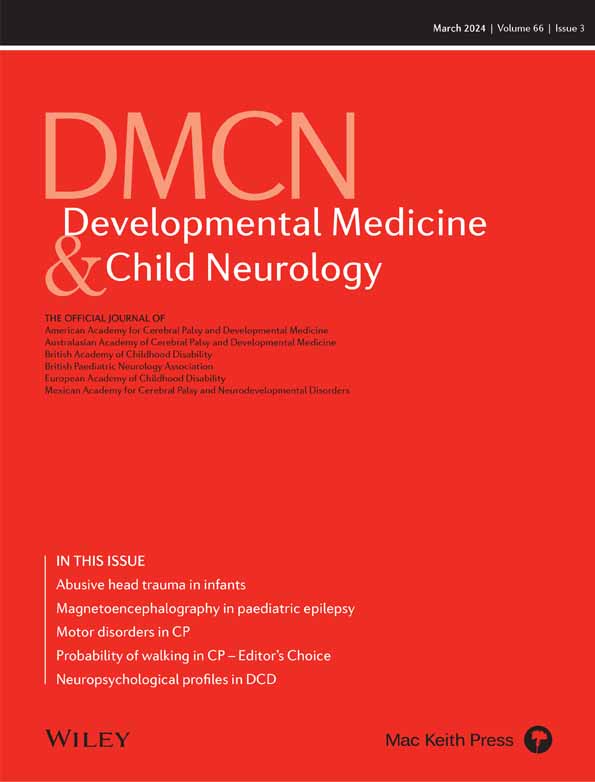Caregiver perspectives on powered mobility devices and participation for children with cerebral palsy in Gross Motor Function Classification System level V
This original article is commented on by Jahan and Islam on pages 276–277 of this issue.
Abstract
Aim
To describe caregiver experiences, perceptions, and device preferences between a modified ride-on car (MROC) and an Explorer Mini, including perceived changes in participation, barriers, and benefits for young children with cerebral palsy (CP) classified in Gross Motor Function Classification System (GMFCS) level V.
Method
A subset of data were analyzed from a larger multisite study. Semi-structured interviews were conducted with 10 caregivers of children with CP in GMFCS level V across a 16-week trial with two mobility devices. Each interview was audio-recorded, transcribed verbatim, and analysed using constant comparison methods.
Results
Seven of 10 caregivers preferred the Explorer Mini over the MROC. Four themes emerged. One related to the perceived benefits and barriers of each device (ease and convenience is essential) and three related to perceived changes in participation: (1) autonomy enacted through mobility; (2) belonging and being present; and (3) participation recognized as an area of growth.
Interpretation
Despite limited consideration of powered mobility for this population, caregivers of children in GMFCS level V reported similar benefits and barriers compared to children in other GMFCS levels shown in the literature. Particularly, caregivers perceived positive changes in their child's participation and recognized the ability for continued improvements in participation when using powered mobility.
What this paper adds
- Children with cerebral palsy classified in Gross Motor Function Classification System level V are often excluded from powered mobility use and research.
- Despite this, caregivers reported positive experiences for their children.
- Caregivers felt that participation in powered mobility led to increased autonomy and overall sense of inclusion and belonging for their children.
- Most caregivers preferred the Explorer Mini over the modified ride-on car but recognized that both devices had benefits and barriers to use.
What this paper adds
- Children with cerebral palsy classified in Gross Motor Function Classification System level V are often excluded from powered mobility use and research.
- Despite this, caregivers reported positive experiences for their children.
- Caregivers felt that participation in powered mobility led to increased autonomy and overall sense of inclusion and belonging for their children.
- Most caregivers preferred the Explorer Mini over the modified ride-on car but recognized that both devices had benefits and barriers to use.
This original article is commented on by Jahan and Islam on pages 276–277 of this issue.
Abbreviation
-
- MROC
-
- modified ride-on car
Cerebral palsy (CP) is the most common childhood-onset disability, with a prevalence of nearly 500 000 children and an incidence of 10 000 new diagnoses annually in the USA.1 Children with CP often experience delays across multiple developmental areas.2 Dynamic systems theory suggests that global delays are due to restrictions in everyday perceptual motor skills and social experiences secondary to mobility limitations.3 Because development occurs from the interaction of multiple components within a person, task, and environment, these components interact when a child attempts to problem-solve or complete a task.3 Therefore, perceptual motor experiences in early childhood are critical for cognitive, social, and communication development.4 Children with CP classified in Gross Motor Function Classification System (GMFCS) level V experience the greatest limitations in self-initiated mobility and are described as dependent for transportation, having limited head and trunk postural control and limited movement of arms and legs.2 Worldwide estimates suggest that about 85% of people with CP align with levels I to IV, while 15% align with level V.5 Children in GMFCS level V often rely on dependent mobility rather than self-initiated mobility, which can limit exposure to these dynamic learning experiences, globally affecting their participation and function long term.6
Powered mobility devices can assist in enhancing such exposure while increasing initiation, self-exploration, and participation during early childhood.7 Historically, there have been limited powered mobility devices for children under 3 years old.8 One option that aimed to fill this gap in mobility technology, which first emerged in the late 1980s but gained greater popularity in the 2010s, were modified ride-on cars (MROCs).9 These are commercial products modified for access and supportive seating with easy-to-press activation switches, polyvinyl chloride pipes, swimming kickboards, pool noodles, harnesses, and Velcro, which cost approximately US$200.8 A newer option, the Explorer Mini (Permobil AB, Timrå, Sweden) is a USA Food and Drug Administration-cleared device commercially released in 2020.10 The Explorer Mini is for children with disabilities aged 12 to 36 months, can be used in a seated or standing position, has a midline 360-degree joystick for driving, and costs approximately US$2700.10 Both of these devices increase self-initiated mobility for children with disabilities in early childhood through unique mechanisms.11, 12
Yet, young children in GMFCS level V continue to be denied opportunities for self-initiated mobility despite the acknowledged right of all children to mobility, play, and the technologies that support enactment of these rights.13 There is a perception that these children may not be purposeful and safe drivers and therefore may not benefit from use.7 However, access to powered mobility devices can provide opportunities to explore ‘tool use learning’, environmental exploration, and developmental gains.7 The extent of these potential benefits is unknown because there is limited research that includes children in GMFCS level V aged under 3 years. Limitations in previous studies include small sample sizes (ranging from one to nine participants), single sessions of device exposure were conducted before the release of the Explorer Mini, or did not distinguish outcomes from children in GMFCS level V from other GMFCS levels.14-17
Rather than solely focusing on the achievement of driving skills, changes in participation and learning may be more meaningful measurements for children in GMFCS level V. Participation in activities of daily living is critical for children to acquire new skills, attain competence, establish meaningful relationships, and achieve quality of life.18-22 Research related to the participation of children with disabilities suggest that to fully benefit from participation, the child must: (1) take part into something or with someone; (2) feel included; (3) have some control over what they are taking part in; and (4) be engaged in something that is personally meaningful.20 Therefore, caregiver perspectives about how their child uses powered mobility devices may provide a meaningful insight into participation.
An understanding of caregiver perceptions about perceived barriers to using MROCs and the Explorer Mini may contribute to the development of strategies to promote dosage adherence in interventions and inform clinical practice and device recommendations for families who have many factors to consider when choosing a device. Therefore, the purpose of the current study was to describe caregiver experiences, perceived changes in participation, barriers, and benefits, as well as device preferences across a 16-week trial with both devices for children with CP aged under 3 years classified in GMFCS level V.
METHOD
This study was part of a multisite, mixed-methods, doubly counterbalanced, randomized, AB crossover clinical trial (see the protocol paper for the full trial description).23, 24 This qualitative study was conducted using a phenomenological framework by interviewing caregivers whose children in GMFCS level V took part in the study.25 This approach provides an analytical perspective focused on understanding a core set of shared experiences of individuals involved in a particular phenomenon.25 All study procedures were approved by a single institutional review board and reliance agreement with the University of Washington Human Subjects Division. Written informed consent and caregiver permission were obtained before the study activities.
Participants
Out of 24 child–family dyads recruited for the overarching study, a subset of 10 dyads in which the child had a clinical presentation consistent with GMFCS level V were included in this study. A demographic survey was completed by caregivers at the initial visit. Children demographics included ages spanning 13 to 32 months (median = 22.1 months; SD = 6.4 months), five females and five males with diverse backgrounds and variability in functional profiles (Table 1). Caregiver demographics included 10 mothers who all identified as female, with diverse backgrounds, employment, educational level, and family income (Table 2).
| n | |
|---|---|
| Sex | |
| Male | 5 |
| Female | 5 |
| Ethnicity | |
| Hispanic or Latino | 2 |
| Not Hispanic or Latino | 8 |
| Primary medical diagnosis | |
| Perinatal stroke | 1 |
| Hypoxic–ischemic encephalopathy | 1 |
| CP | 5 |
| Hypotonic CP | 1 |
| Spastic bilateral CP | 2 |
| GMFCS level V | 10 |
| Mini-MACS level | |
| II | 1 |
| III | 2 |
| IV | 2 |
| V | 5 |
| CFCS level | |
| IV | 4 |
| V | 6 |
| Mini-EDACS level | |
| II | 1 |
| III | 1 |
| IV | 3 |
| V | 5 |
- Abbreviations: CFCS, Communication Function Classification System; CP, cerebral palsy; GMFCS, Gross Motor Function Classification System; Mini-EDACS, Mini-Eating and Drinking Ability Classification System; Mini-MACS, Mini-Manual Ability Classification System.
| n | |
|---|---|
| Sex | |
| Female | 10 |
| Ethnicitya | |
| Hispanic or Latino | 2 |
| Not Hispanic or Latino | 7 |
| Educational level | |
| Some high school | 1 |
| Some college | 2 |
| Associate's degree | 1 |
| Bachelor's degree | 4 |
| Master's degree | 1 |
| Doctoral degree | 1 |
| Employment | |
| Unemployed | 6 |
| Part-time | 2 |
| Full-time | 1 |
| Unknown | 1 |
| Household income | |
| < US$24 999 | 1 |
| US$50 000–74 999 | 2 |
| US$75 000–99 999 | 1 |
| > US$100 000 | 5 |
| Not reported | 1 |
- a One caregiver did not wish to disclose.
Procedures
Data collection occurred over a 16-week period in the home setting according to the study protocol.23 Each child completed an 8-week trial period using each device, a Fisher-Price Lightening McQueen (Fisher-Price, East Aurora, NY, USA) 6 V MROC and the Explorer Mini with no washout period and randomized device order. A functional profile assessment was completed by caregivers at the initial visit based on descriptors from the GMFCS,2 Mini-Manual Ability Classification System, Communication Function Classification System, and Mini-Eating and Drinking Ability Classification System (Appendix S1).26
GMFCS levels were stable over time for children older than 2 years.26 However, for children under 2 years, the GMFCS should be used with caution because children's functional abilities may still change during this rapid developmental stage.26
Semi-structured interviews were conducted using an interview guide (Figure 1) to understand caregiver perceptions on the benefits and barriers per device, changes to their child's participation, and overall device preference. Questions related to participation were assessed for how they fitted into the six experiential aspects of participation previously suggested in the literature.22 The interviews lasted 20 to 30 minutes and occurred at baseline, mid-study, and at study completion, with data from interviews mid-study and at study completion (after device exposure) used for the current analysis. All 20 interviews were audio-recorded, transcribed verbatim, and de-identified by the research team. The first author reviewed all transcripts to ensure consistency and caregivers were invited to review their transcripts if desired. Researcher positionality is included in Figure 1.
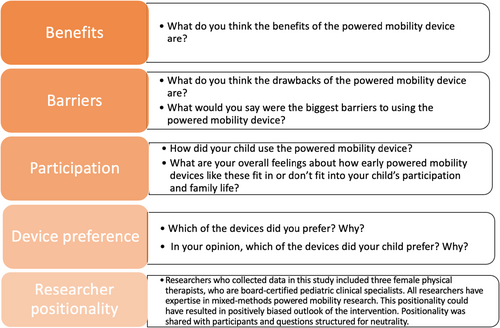
Data analysis
The first author used first impression and summative memos to describe the main points of the interviews, emerging concepts, and reflections after transcription. The first author coded all the data, which were reviewed by the other authors. The NVivo qualitative coding software (Lumivero, Denver, CO, USA)27 was used for data analysis. The coding process included using a constant comparative method to create open codes and focused codes of each caregiver's transcripts until data saturation occurred and themes emerged (Figure 2).25 An e-mail summary of the themes was shared with caregivers as a form of member checking to ensure accuracy and avoid misrepresentation of the data.25
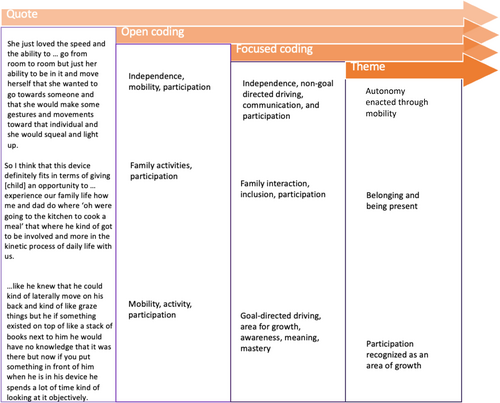
Matrix coding queries were then conducted to assess patterns and response frequency in the data. These queries consisted of assessing what barriers, benefits, and participation topics were reported for each of the devices, the MROC and the Explorer Mini (see Appendix S2 for the codebook). Attributes were assigned to the device used at the time of the interview (MROC or Explorer Mini). A frequency count was conducted to show the number of occurrences of each response by each caregiver (Figures 3-5). Frequency counts can show emergent patterns in the data and help identify common themes. All changes to codes and themes were tracked using an audit trail.
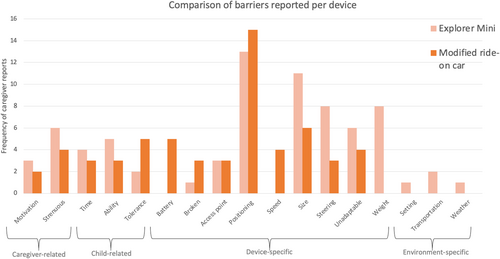
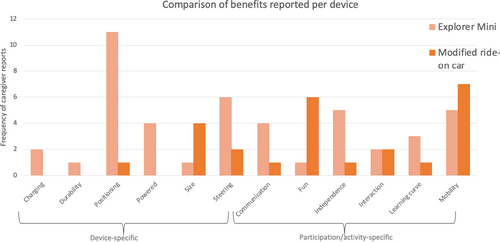
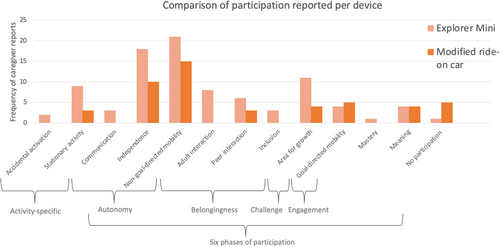
RESULTS
Out of the 10 caregivers, seven preferred the Explorer Mini and three preferred the MROC. However, caregivers reported that eight of the children preferred the Explorer Mini and two preferred the MROC. Four themes emerged. One related to the perceived benefits and barriers of each device (ease and convenience is essential) and three related to perceived changes in participation: (1) autonomy enacted through mobility; (2) belonging and being present; and (3) participation as an area of growth.
Ease and convenience is essential
This theme describes the perceived barriers and benefits caregivers reported to powered mobility device use. Often, caregivers had juxtaposing perceptions about a given feature, where some described the feature as a benefit, while others described it as a barrier.
For both devices, the most common barriers described were related to strain of use for caregivers, positioning, and limited adaptability for the needs of the individual child (Figure 3). The primary barriers reported for the Explorer Mini included positioning, size, weight, and steering. Caregivers were challenged by the limited positioning options available on the Explorer Mini that precluded the addition of a five-point harness or the ability to lean the seat back to help children who needed more support for trunk or head control (Table 3, quote 1). Caregivers expressed a desire that the Explorer Mini could be smaller, as the device was perceived as cumbersome and taking up a lot of space in the home (Table 3, quote 2). Caregivers reported challenges with transporting the Explorer Mini even though it is much lighter than traditional powered wheelchairs, which led to primary use indoors (Table 3, quote 3). Lastly, caregivers reported that the joystick was too advanced for their child at a novice learning stage and expressed a desire for joystick adjustability (Table 3, quote 4).
| Quote no. | Quote |
|---|---|
| Theme: Ease and convenience is essential | |
| 1 | We worked out ways to make it more supportive for her, but it would be hard to modify it- to make it really give her enough head support, um so that was I would say that's the one downside to that is just the lack of support for- for her trunk and head |
| 2 | Technology requires so much that like the size can sometimes be a drawback in and of itself and kind of like hinder its accessibility for things that we want to do |
| 3 | It's heavy, it's very heavy, so taking out in the community, that would be hard |
| 4 | Uh, the joystick, um, for, for someone like her it's too advanced, it's too difficult for her to, to move it that way, um, I would say that's the only problem that I say |
| 5 | The low- the low- the low trunk tone and um lack of head control has meant that it's been very hard to get her comfortable in the uh the powered car and so she's already pretty upset when we get started and so kind of you know either [laughs] doesn't improve from there or deteriorates from there. It doesn't seem- it doesn't seem like a great fit for her … |
| 6 | The sides I feel like kind of like having issue getting her in and out and then like not being able to push it like lean it back if I need to or like push it back for like more space and like normal cars you like oh I can push it back a little back give myself some space |
| 7 | I think some sort of independent parent steering … for the parent to use you know maybe like a you know like a handlebar on the back or something |
| 8 | I think that because it is like a pre-manufactured toy it's not as customizable as the more like medical-grade equipment is uh, and so for like long boys like [child] it can be uncomfortable to have his, like, knees on stuff. |
| 9 | And I liked that she didn't have to be strapped into it that she could just be put in and she was ready to go. |
| 10 | Um, I would say the steering is really good. Um, and well, really good as in super smooth, tighter turns, and I would think a little um, more accurate, I guess. The way it maneuvers. |
| 11 | So, if there's a benefit it's independent mobility |
| 12 | Um I definitely think the benefits of it are I love that it is just one big button like it's pretty straightforward and it's pretty simple I like that there's not like a lot to do like they just the button big |
| 13 | Yeah, he mostly just was in it while we were pressing the button and moving so it was just a fun toy. |
| 14 | It's small enough that we can move it |
| Theme: Autonomy enacted through mobility | |
| 15 | I think it is a way that he can move himself. And I think that's the benefit is that we move them around in strollers and wheelchairs and things. But I think he understood that this was something he could move. And he responded very differently to that, versus just sitting passively in something |
| 16 | But also, exciting just seeing her anytime she's just up and about and is really fun to see and especially as the parent if we don't know how to be the one that's carrying her all the time, that's a win win. |
| 17 | Yeah, she tended to go in circles a lot. Because she would get her hand, kind of, in one position on it and it would keep going. |
| 18 | I don't think he uses it to get from point A to point B in his cognition of it, but he loves that it is fun, he just thinks it's fun |
| 19 | He understands most everything said around him, picks up on like social context and things like that so um it was nice to see that play out in a way where um he got to just kind of like be a toddler like ‘C don't bump into that’ he'd like giggle and very purposely bump into what you just said not to |
| Theme: Belonging and being present | |
| 20 | Um, I like I would totally like keep trying him in like the toy car like just to play outside with his siblings. Like, um, I mean especially with the spina bifida aspect, it's going to be a long time for him to even like be able to use his feet, um if at all. So, I think just being able to play I think he'll be a happier little kid being able to play with neighborhood kids or his siblings. |
| 21 | The best thing about it was her brothers loved it and she would sit in it and they would play with it with her and hold her hand and drive it for her. And that was one of the best ways to use it was to play with her brothers. |
| 22 | Um I- I like it um you know even if it is just something that she wants to sit in which is what we did with the Explorer Mini a lot you know if we were playing um in the play room or if I was doing something in the kitchen she would be happy to just be in it |
| 23 | Yeah, and so it felt like she was a little more, um, present with those around her. And that she could maneuver it in so many cool ways. Um, and it was so responsive. That, we liked that about the Explorer. The car felt more like a toy, a little bit to us, and less like a mobility device. |
| 24 | Children … that are not ambulatory and can't move around at all don't get to know so they never get to really experience independent thought outside of like something that somebody else is putting in front of them so it's I think the benefits are just allowing a child to develop and understand their individuality and uniqueness in the world around them and kind of like the fun chaotic ways that only toddlers can |
| Theme: Participation as an area of growth | |
| 25 | She started the other one I was worried that she would be able to push a button and at first it was a little harder now she is really great at pushing buttons. |
| 26 | This could be something that she would develop um if she had more time with it but she was not really steering it very purposefully or intentionally um and so there was you know a degree of you know fine motor limitation to being able to steer… although it was it- it did offer her the ability to move it on its own more than the car did so… that was good for her. |
| 27 | Feel like was easier for her and with her being kind of behind just the big button was really nice because it was big so she didn't have to touch this little thing so all she would have to do would touch it, put her little hand on it. |
| 28 | Whether that's to like getting into a cupboard or um knock something over, or even to just to run into something and just experience the sensory input of like hitting something solid um whereas before he didn't do that |
| 29 | So hopefully, hopefully one day she'll be even better at like, you know, intentionally grabbing what she wants and making it move in a direction um that she wants. |
| 30 | Especially when he makes that connection that, you know, I'm moving this, and I can choose to move this. |
The most commonly reported barriers for the MROC were quite similar to the Explorer Mini (Figure 3). Barriers to positioning for the MROC primarily related to either a lack of tolerance for more extensive supports incorporated for upright positioning, or conversely, a lack of needed support for functional positioning (Table 3, quote 5). Overall, MROC size was reported as a barrier, with caregivers describing a lack of space for their child's knees between the seat and the dashboard, especially if wearing shoes or orthoses. MROCs were mostly used outside due to a larger turning radius (Table 3, quote 6). Strain of use was also reported for MROCs, but this was more related to caregivers bending down to help with steering or repositioning (Table 3, quote 7). Lastly, due to the MROC being an off-the-shelf device that was modified, caregivers felt that it was challenging to adapt it to their child's needs compared to a ready-made mobility device (Table 3, quote 8).
For both devices, the most common benefit included an increase in mobility (Figure 4). The primary reported benefits for the Explorer Mini were positioning, steering, independence, and mobility. For example, caregivers reported the ease of transferring the child in the device and increased child tolerance without needing any extra strapping (Table 3, quote 9). Despite the simultaneously reported challenges, caregivers viewed joystick steering as more achievable than physically turning the steering wheel in the MROC (Table 3, quote 10). Caregivers felt the Explorer Mini made their child more independent and mobile in their environments (Table 3, quote 11).
The primary reported benefits for the MROC included mobility, fun, and size (Figure 4). Caregivers felt their children were more mobile in the MROC because the switch was a large target for their child to hit and many children could access it without assistance, despite needing assistance for steering (Table 3, quote 12). Caregivers reported their child's enjoyment of the MROC and expressed their own perceptions of the device as more of a toy, rather than a therapeutic device (Table 3, quote 13). Lastly, caregivers thought the more compact size and lighter weight of the MROC was a benefit (Table 3, quote 14).
Autonomy enacted through mobility
This theme describes caregiver perceptions of a new experience of autonomy for their child during powered mobility use. Caregivers reported that autonomy was enacted in three ways: communication; independence; and non-goal-directed mobility (i.e. exploration) (Figure 5). For example, children were viewed as more independent because they were able to move about their environment themselves, rather than being carried or pushed (Table 3, quotes 15 and 16). Children had new, self-initiated mobility experiences, such as spinning in circles, or free exploration (Table 3, quotes 17 and 18). Many caregivers reported that the Explorer Mini, more so than the MROC, had an impact on choice and control through communicating in new ways, such as gesturing or vocalizing (Table 3, quote 19). Both devices increased independence and non-goal-directed mobility overall; however, caregivers reported these perceptions more frequently with the Explorer Mini (Figure 5).
Belonging and being present
The third theme describes caregiver perceptions of their child's participation and belonging. Caregivers reported that both powered mobility devices increased their child's participation and belonging through interaction and inclusion (Figure 5). The MROC was used primarily outdoors, where the child could be more actively involved and ‘present’ in play with their siblings (Table 3, quote 20). For the Explorer Mini, indoor play included sibling-assisted driving, playing chase, or simply engaging in upright interaction (Table 3, quote 21). Contrastingly, the Explorer Mini was the only device reported to foster adult or caregiver interaction, during activities such as meal preparation, or natural movement throughout the home environment (Table 3, quotes 22 and 23). Caregivers felt their child was able to interact in family life to a greater extent when using both powered mobility devices (Table 3, quote 24).
Participation as an area of growth
The final theme describes caregiver perceptions of areas of growth and future potential that were recognized in their children using powered mobility. Both devices were perceived as new opportunities for their child that could provide challenge, engagement, mastery, and meaning (Figure 5). Caregivers reported that both devices challenged their children in different ways. For example, challenge came in the form of the devices' unique activation mechanisms as well as participating in incidental, exploratory, and early goal-directed mobility (Table 3, quotes 25 and 26). There was some discussion among caregivers about opportunities to ‘grow into’ the devices, grounded in their child's learning stage and functional ability at the time of the study (Table 3, quote 27). Some children achieved increased engagement through goal-directed driving; children used the devices to go get a snack, chase a dog, chase their siblings, or move toward something they wanted (Table 3, quote 28). Mastery was alluded to by caregivers describing specific goals they thought their children could achieve in the future because of powered mobility experience (Table 3, quote 29). Meaning was described by caregivers, who observed the cause-and-effect learning opportunities that resulted from activating the switch or joystick (Table 3, quote 30). These perceptions of cognitive developmental gains were common, even in caregivers who felt their child's participation did not change drastically because of powered mobility.
DISCUSSION
This study offered a unique opportunity to address a critical knowledge gap in powered mobility literature for enhancing participation in young children with CP classified in GMFCS level V. Caregivers expressed numerous benefits and challenges to their child's use of both devices, yet consistently described how the opportunity to trial the devices enhanced participation in the form of autonomy and belonging, growth potential, engagement, and making new developmental connections. These responses align with previous literature describing the multifaceted components of defining and enacting meaningful participation for children with disabilities.20, 22
Regarding device preference, most caregivers and children in this study preferred the Explorer Mini. One theme showed that caregivers want devices that are easy and convenient. This echoes research indicating that families experienced barriers to using a MROC in real-world settings.28 Caregivers reported barriers most prevalently related to the device, environment, but also related to child-related barriers (i.e. health, tolerance, and abilities) and caregiver-related barriers (i.e. physical requirements, time, and motivation).28 Similarly, caregivers in this study most frequently reported device barriers such as size, weight, positioning, and steering, but provided unique examples based on the device. For example, caregivers reported that the Explorer Mini was easier to use and that their children tolerated this device better; however, those who preferred MROCs noted it was better for outdoor driving environments. This highlights the importance of a multimodal mobility perspective where caregivers and children can choose the right device for the right environment based on their needs and preferences.8, 29 This perspective may be especially useful for pediatric therapists who work with this population and aligns with previous work, which suggests that device preference is complex and influenced by caregiver and child factors.17, 30
The results of this study align with dynamic systems theory showing that the task (mobility) is influenced by the individual (level of function) and the environment (device characteristics).3 Clinicians have an opportunity to educate families about these factors and relevant device features or modifications that will contribute to successful use of powered mobility. Factors such as positioning, the child's abilities to steer, and caregiver goals for participation can help inform decisions for which device(s) are best. Education can also be provided to mitigate known barriers, such as easier ways for device transport, locating accessible environments in their community, or sharing activities to perform in the device. This can also be a valuable opportunity to educate families about the expectations of device use (i.e. exploration and participation rather than goal-directed driving).
A strength of this study was its centering on the lived experience of caregivers and children in GMFCS level V. Focusing on this population is critical given that they have been systemically excluded from powered mobility research and practice because of inclusion criteria based on a threshold of functional ability (i.e. can sit with support), a perception of the necessity for ‘readiness’ requirements of device access, or the focus of pediatric rehabilitation on the skill of walking above other functional skills.8, 29 This is also the largest study to focus exclusively on young children in GMFCS level V (n = 10) within the context of a powered mobility intervention, which begins to fill a critical knowledge gap. Caregivers underscored the importance of self-initiated mobility for their children in GMFCS level V, including an emphasis on how mobility facilitates autonomy and belonging through participation.
A significant limitation of this study is that while our sample was diverse in terms of participant ethnicity, neighborhood environment, socioeconomic status, and functional profiles, all caregivers interviewed were females (mothers); it is unknown if differences in perception may be mediated by sex. Other demographic factors did not explicitly arise among participant responses, but these probably intersect alongside childhood disability in unique ways that may have influenced caregiver experiences with powered mobility devices and should be explored further. Another limitation is that data were primarily collected during the summer and autumn months (June through November) and may have influenced device use patterns both outdoors and indoors. This limitation was partially mitigated through counterbalancing device order among participants. Lastly, all researchers who collected data are pediatric physical therapists, which may be a limitation. Researchers attempted to remain neutral regarding feelings about powered mobility use for each child. However, caregivers may have experienced acquiescence bias and felt the need to respond more positively about powered mobility than they truly felt due to this power dynamic. To mitigate this bias, the researchers engaged in unconditional positive regard for positive and negative participant responses, explicitly sought opposing perspectives, engaged in reflexivity, and acknowledged positionality when interpreting the words of caregivers.
Future directions of research should compare these results to other children in this study classified in different GMFCS levels. Additionally, future research addressing how children in GMFCS level V learn to use powered mobility may inform the design and implementation of interventions. Research has assessed if children in GMFCS level V can use powered mobility devices,11, 15-17 but there is limited information that addresses the methods and expectations for teaching powered mobility skills, as well as the potential participation benefits noted by the caregivers in this study. Future research could further assess participation as an outcome, differences in access methods (joystick vs switch) for children in GMFCS level V at varying Mini-Manual Ability Classification System levels, or evaluate outcomes if multi-week trials of powered mobility devices became a national standard of care.
In conclusion, children in GMFCS level V were able to use both powered mobility devices throughout the study, with an overall preference for the Explorer Mini. Caregivers reported several benefits and barriers related to both devices, but overall found that their child was successful in using powered mobility, with positive contributions to participation, autonomy, belonging, and recognized participation, as well as mobility as an area of growth. This is one of the first studies to provide caregiver feedback related to the newly available Explorer Mini device. Children with CP, regardless of GMFCS level, deserve equitable access to powered mobility to promote self-initiated mobility skills. Including qualitative caregiver perspectives among other outcome measures appropriate for assessing mobility and participation outcomes for children with CP can be a powerful tool to leverage in future translational research.
Open Research
DATA AVAILABILITY STATEMENT
Data sharing not applicable to this article as no datasets were generated or analysed during the current study



